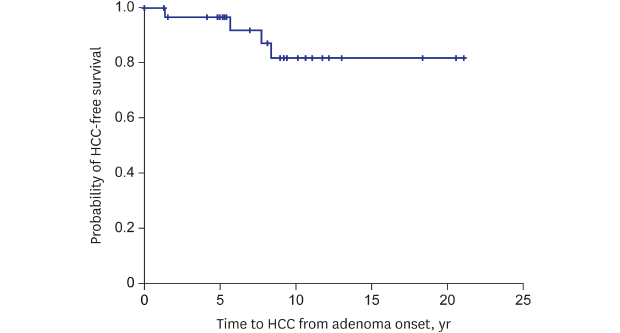1. Alshak NS, Cocjin J, Podesta L, van de Velde R, Makowka L, Rosenthal P, et al. Hepatocellular adenoma in glycogen storage disease type IV. Arch Pathol Lab Med. 1994; 118(1):88–91.

2. Rake JP, Visser G, Labrune P, Leonard JV, Ullrich K, Smit GP. Glycogen storage disease type I: diagnosis, management, clinical course and outcome. Results of the European Study on Glycogen Storage Disease Type I (ESGSD I). Eur J Pediatr. 2002; 161 Suppl 1:S20–S34.

3. Di Rocco M, Calevo MG, Taro' M, Melis D, Allegri AE, Parenti G. Hepatocellular adenoma and metabolic balance in patients with type Ia glycogen storage disease. Mol Genet Metab. 2008; 93(4):398–402.

4. Kharsa G, Degott C, Filoche B, Hedde JP, Potet F, Benhamou JP. Hepatic adenoma and hepatocellular carcinoma in 3 brothers with type I glycogenosis. Gastroenterol Clin Biol. 1990; 14(1):84–89.

5. Kudo M. Hepatocellular adenoma in type Ia glycogen storage disease. J Gastroenterol. 2001; 36(1):65–66.


6. Lee YM, Jun HS, Pan CJ, Lin SR, Wilson LH, Mansfield BC, et al. Prevention of hepatocellular adenoma and correction of metabolic abnormalities in murine glycogen storage disease type Ia by gene therapy. Hepatology. 2012; 56(5):1719–1729.

7. Reddy SK, Kishnani PS, Sullivan JA, Koeberl DD, Desai DM, Skinner MA, et al. Resection of hepatocellular adenoma in patients with glycogen storage disease type Ia. J Hepatol. 2007; 47(5):658–663.


9. Weinstein DA, Wolfsdorf JI. Effect of continuous glucose therapy with uncooked cornstarch on the long-term clinical course of type 1a glycogen storage disease. Eur J Pediatr. 2002; 161 Suppl 1:S35–S39.

12. Sakellariou S, Al-Hussaini H, Scalori A, Samyn M, Heaton N, Portmann B, et al. Hepatocellular adenoma in glycogen storage disorder type I: a clinicopathological and molecular study. Histopathology. 2012; 60(6B):E58–E65.

13. Ibarrola C, Castellano VM, Colina F. Focal hyperplastic hepatocellular nodules in hepatic venous outflow obstruction: a clinicopathological study of four patients and 24 nodules. Histopathology. 2004; 44(2):172–179.


14. Choi Y, Yi NJ, Ko JS, Moon JS, Suh SW, Lee JM, et al. Reappraisal of the role of portacaval shunting in the growth of patients with glycogen storage disease type I in the era of liver transplantation. Transplantation. 2016; 100(3):585–592.


15. Sakamoto A, Hayashi H, Sakamoto I, Isomoto I, Eguchi S, Takatsuki M, et al. Multiple hepatocellular adenomas in a patient with glycogen storage disease type I: various enhancement patterns in MRI with Gd-EOB-DTPA. Abdom Imaging. 2012; 37(2):239–243.


16. Lee PJ. Glycogen storage disease type I: pathophysiology of liver adenomas. Eur J Pediatr. 2002; 161 Suppl 1:S46–S49.

17. Franco LM, Krishnamurthy V, Bali D, Weinstein DA, Arn P, Clary B, et al. Hepatocellular carcinoma in glycogen storage disease type Ia: a case series. J Inherit Metab Dis. 2005; 28(2):153–162.


18. Nguyen AT, Bressenot A, Manolé S, Galloy MA, Bronowicki JP, Vidailhet M, et al. Contrast-enhanced ultrasonography in patients with glycogen storage disease type Ia and adenomas. J Ultrasound Med. 2009; 28(4):497–505.


19. Matern D, Starzl TE, Arnaout W, Barnard J, Bynon JS, Dhawan A, et al. Liver transplantation for glycogen storage disease types I, III, and IV. Eur J Pediatr. 1999; 158 Suppl 2:S43–8.

21. Malatack JJ, Finegold DN, Iwatsuki S, Shaw BW Jr, Gartner JC, Zitelli BJ, et al. Liver transplantation for type I glycogen storage disease. Lancet. 1983; 1(8333):1073–1075.


22. Labrune P. Glycogen storage disease type I: indications for liver and/or kidney transplantation. Eur J Pediatr. 2002; 161 Suppl 1:S53–S55.

23. Brooks ED, Koeberl DD. Large animal models and new therapies for glycogen storage disease. J Inherit Metab Dis. 2015; 38(3):505–509.


24. Coire CI, Qizilbash AH, Castelli MF. Hepatic adenomata in type Ia glycogen storage disease. Arch Pathol Lab Med. 1987; 111(2):166–169.

25. Nakamura T, Ozawa T, Kawasaki T, Nakamura H, Sugimura H. Glucose-6-phosphatase gene mutations in 20 adult Japanese patients with glycogen storage disease type 1a with reference to hepatic tumors. J Gastroenterol Hepatol. 2001; 16(12):1402–1408.


26. Ko JS, Yang HR, Kim JW, Seo JK. Clinical findings of genotypes in Korean patients with glycogen storage disease type Ia. Korean J Pediatr. 2005; 48(8):877–880.








 PDF
PDF Citation
Citation Print
Print




 XML Download
XML Download